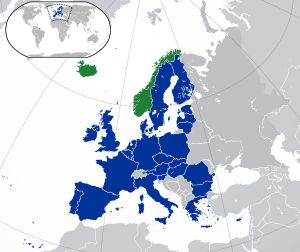Committee of Permanent Representatives
COREPER, from French Comité des représentants permanents, is the Committee of Permanent Representatives in the European Union, made up of the head or deputy head of mission from the EU member states in Brussels.[1]
- For the OIC Committee of Permanent Representatives, see OIC Committee of Permanent Representatives.
Its defined role is to prepare the agenda for the ministerial Council of the European Union meetings; it may also take some procedural decisions. It oversees and coordinates the work of some 250 committees and working parties made up of civil servants from the member states who work on issues at the technical level to be discussed later by COREPER and the Council. It is chaired by the Presidency of the Council of the European Union.
There are in fact two committees:
- COREPER I consists of deputy heads of mission and deals largely with social and economic issues;[2]
- COREPER II consists of heads of mission (Ambassador Extraordinary and Plenipotentiary) and deals largely with political, financial and foreign policy issues.[3]
Representatives of the Council Secretariat from the relevant Directorates and from the Legal Directorate are also present.
Weekly meetings are held in private; the agenda of the meeting is divided into
- a part "I" (I points, items scheduled without debate) and
- a part "II" (II points, items scheduled for debate).
They divide the ministerial agenda into three categories:
- I points which are for information and no ministerial decision is needed;
- A points where the decision can be made without debate (but it has to be put off the agenda of this meeting if any national delegation opposes it being decided) and is often on a subject outside the detailed responsibility of the particular group of ministers;
- B points where debate is needed and the decision may not be known in advance.
An item may be described internally as a false B point - this is to give the public impression as a B point that ministers are actively debating it because of its importance when in fact it could have been treated as an A point because negotiation and compromise has already taken place in COREPER. Relatively few decisions are taken by ministers on true B points: they are usually sent back to COREPER until they can be returned as an A point or a false B point.
The deliberations and decisions of the Council itself under the co-decision procedure are, unlike all other Council meetings, including COREPER and Council working group meetings, public.
Article 240 of the Treaty on the functioning of the European Union lays down the legal basis of COREPER.
Coreper I, comprising the Deputy Permanent Representatives, prepares the ground for the following Council configurations:
- Employment, Social Policy, Health and Consumer Affairs;
- Competitiveness (internal market, industry, research, space and tourism);
- Transport, Telecommunications and Energy;
- Agriculture and Fisheries;
- Environment;
- Education, Youth, Culture and Sport (including audiovisual);
Coreper II, comprising the Permanent Representatives, prepares for the other configurations:
- General Affairs
- Foreign Affairs (including European security and defence policy and development cooperation);
- Economic and Financial Affairs (including the budget);
- Justice and Home Affairs (including civil protection).
Security role
The EU command and control (C2) structure, as directed by political bodies which are composed of member states's representatives and generally require unanimous decisions, as of April 2019:[4]
- Liaison: Advice and recommendations Support and monitoring Preparatory work
| Political strategic level: | |||||||||||||||||||||||||||||||||
| ISS | EUCO Pres. (EUCO) | Chain of command | |||||||||||||||||||||||||||||||
| Coordination/support | |||||||||||||||||||||||||||||||||
| SatCen | CIVCOM | HR/VP (FAC) | |||||||||||||||||||||||||||||||
| INTCEN | HR/VP (PMG) | HR/VP (PSC) (******) | CEUMC (EUMC) | ||||||||||||||||||||||||||||||
| CMPD | DGEUMS (***) (EUMS) | ||||||||||||||||||||||||||||||||
| Military/civilian strategic level: | |||||||||||||||||||||||||||||||||
Dir MPCC (***) (MPCC) | JSCC | Civ OpCdr CPCC(*) | |||||||||||||||||||||||||||||||
| Operational level: | |||||||||||||||||||||||||||||||||
| MFCdr (****) (MFHQ) | HoM (*) | ||||||||||||||||||||||||||||||||
| Tactical level: | |||||||||||||||||||||||||||||||||
| CC(**) Land | CC(**) Air | CC(**) Mar | Other CCs(**) | ||||||||||||||||||||||||||||||
| Forces | Forces | Forces | Forces | ||||||||||||||||||||||||||||||
- *In the event of a CSDP Civilian Mission also being in the field, the relation with the Civilian Planning and Conduct Capability (CPCC) and its Civilian Operation Commander (Civ OpCdr), as well as the subordinate Head of Mission (HoM), are coordinated as shown.
- **Other Comonent Commanders (CCs) and service branches which may be established
- ***The MPCC is part of the EUMS and Dir MPCC is double-hatted as DGEUMS. Unless the MPCC is used as Operation Headquarters (OHQ), either a national OHQ offered by member states or the NATO Command Structure (NCS) would serve this purpose. In the latter instance, Deputy Supreme Allied Commander Europe (DSACEUR), rather than Dir MPCC, would serve as Operation Commander (OpCdr).
- ****Unless the MPCC is used as Operation Headquarters (OHQ), the MFCdr would be known as a Force Commander (FCdr), and direct a Force Headquarters (FHQ) rather than a MFHQ. Whereas the MFHQ would act both on the operational and tactical level, the FHQ would act purely on the operational level.
- *****The political strategic level is not part of the C2 structure per se, but represents the political bodies, with associated support facilities, that determine the missions' general direction. The Council determines the role of the High Representative (HR/VP), who serves as Vice-President of the European Commission, attends European Council meetings, chairs the Foreign Affairs Council (FAC) and may chair the Political and Security Committee (PSC) in times of crisis. The HR/VP proposes and implements CSDP decisions.
- ******Same composition as Committee of Permanent Representatives (COREPER) II, which also prepares for the CSDP-related work of the FAC.
See also
References
- "Glossary of summaries - EUR-Lex". eur-lex.europa.eu. Retrieved 2018-05-25.
- "Coreper I - Consilium". www.consilium.europa.eu. Retrieved 2018-05-25.
- "Coreper II - Consilium". www.consilium.europa.eu. Retrieved 2018-05-25.
- EU Command and Control, p. 13, Military Staff



